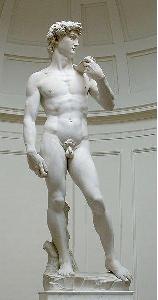
“This,” I thought, “is a work of brilliance!” Ah, but there’s more to the story, as I learned.
Inspiration AND Perspiration
The European Renaissance was a time of great innovation marked by a surge of new knowledge and captured in architecture, sculpture, music, and painting. Before I visited Italy this spring, I imagined gifted Renaissance masters spending their days in sunlit studios, painting or sculpting great works of art in a flowing, effortless climate of creativity and support.
The truth, I learned, was far from my fantasy. Many of those whom we now call Masters were, in their time, mere wage slaves, often struggling to live on a fixed budget set by a wealthy patron who wanted a specific project done on a deadline. Good oil paints, gilt, quality canvas, and fine Carrera marble were not cheap, so these artists were very careful in their use of resources.
Out of necessity, then, they spent long hours preparing for their commission. A painting would be sketched in parts and done in miniature to work out spacing many times before moving to a larger field. Then there would be endless pencil and charcoal sketches before final application of oils and gilt onto the final medium (e.g. wood, canvas, or the dome of a cathedral).
Sculptors followed a similar process. First, multiple sketches; then multiple miniatures of different sizes and in different poses and in different media (e.g. clay, stone) and with varying levels of detail attended to in each piece, so that by the time they put chisel to marble they literally “knew” the work in their head, hands and heart.
Practice is the surest path to Mastery.
I now appreciate that the works of the masters really was WORK. Sure, some of them were brilliant. Yet it was their attention to the tiny details that led to “perfection.” Before he created the David in its full splendor, Michelangelo made hundreds of sketches and miniatures, gradually increasing in size and detail. The final product, then, was not a singular act – it was the manifestation of practice, practice, and more practice.
Apply the Learning of the Masters to YOUR Goals
Follow the example of the Masters to improve your probability of success:
- Picture your goal. 80% of your brain’s processing is visual, so writing or drawing what you want brings your goal alive.
- Create it in miniature. Big, life-shifting goals generally flop because your system can’t shift that much, that fast. Break your goal into tiny pieces you can implement one at a time, to see how they “fit” into your life/work.
- Get feedback. Share your progress with others, both for support as well as for ideas to make it better/easier.
- Adjust, adjust, adjust. The “marble” of your current habits may not cut exactly as you planned, so don’t be afraid to tweak your design as you go so that it fits into your current reality.
- If it’s not working for you, take it as a lesson and move on. The most moving artwork I saw in Italy was Michelangelo’s “Unfinished Slaves,” a major commission he never finished. Yet he saw them as a great accomplishment, because he learned so much from the process.
- Ground it in your bones. Work on some part of your goal every day. The journey is about progress, not perfection. Some days you’ll finish a mural – other days a single brushstroke may be all you can do – yet your constant attention will build goal intimacy.
- Risk, learn, and grow. Michelangelo was a sculptor, and he resisted taking up a brush – yet today the Sistine Chapel is considered his greatest performance.
- Finally, find the Joy. In the end, choose goals that take care of your passions and feed what YOU really want from life, career, and relationships.

What a great way to inspire someone whose anxious about his/her goals. Nothing could have been better than David and Michelangelo’s example ! Well I think my goal is to complete my studies , I feel I should go for further studies because that’s where I find my goal lying. As you said success is not about perfection, it’s about progress , I will take tiny steps towards my goal.Thanks:)This was truly a very motivational post!
How motivated are you?
The test finds out how inspired you really are.
https://3smartcubes.com/pages/tests/motivation/motivation_instructions.asp